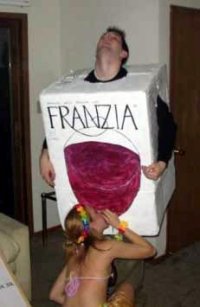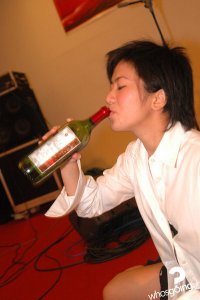If you think Canada = Icewine, you'd be right.
If you think of Canada for world-class sparkling wines, you'd be right again. Really.
ot since New Zealand hijacked the Sauvignon Blanc grape has one country so successfully dominated the international market with a wine style. That’s what Canada has managed to accomplish in a mere decade or so with Icewine.
Eiswein is a German invention that dates back to the late eighteen century when a freak drop in temperature froze the Late Harvest grapes in Franconia before they could be picked. Today true vine-frozen Icewine (Eiswein) is made in Germany, Austria, Czech Republic, Hungary, Luxembourg, New Zealand, Romania, Slovenia and Switzerland; but it is Canada that has co-opted Icewine and made it its own.
Icewine comprises a good 80 per cent of Canadian wine exports. It was originally made from Vidal or Riesling, but today you can get it in virtually every variety that’s planted. You want Semillon Icewine? Pillitteri has it. Chenin Blanc? Inniskillin Okanagan. Shiraz? Konzelmann. Meritage? Royal de Maria.
But you cannot sustain an industry in the long term on a single wine, especially one that has its major market in the Far East. China will soon be making Icewine in its own vineyards. And when that happens, they’ll be undercutting the price mightily for the rest of the world.
A Sparkling Alternative to Ice
I have always believed that Canada should be a major producer of sparkling wines.
In many vintages growers cannot get optimum ripeness to produce balanced table wines; but the grapes for sparkling wines are picked with lower sugars and higher acids than table wines.
Even in poor years Canadian growers can achieve the requisite sugar and acid levels for sparkling wines. So why don’t we play to our strengths? The sparkling wine category is growing internationally - the Champenois can't keep up with demand and are not only planting new vineyards but are looking north to Sussex and Kent in England to buy vineyard land.
Peter GambleThe move to sparkling is already beginning to happen in Nova Scotia. A key player is French winemaker Rafael Brisbois, whose resumé includes making Champagne for Piper Hiedsieck, starting up the Omar Khayyam sparkling house in India, consulting to Iron Horse and Piper Sonoma in California and Blue Mountain in BC. Brisebois is now working with Benjamin Bridge Vineyards, a new winery in Nova Scotia's Gaspereau Valley. Ontario’s Peter Gamble, who is also consulting on the project, believes that Nova Scotia could soon be making sparkling wine in the classic Champenois style. “You’re getting minerality as opposed to fruit here. It has tremendous potential. We’re planning to leave (our) wine six or seven years on the lees. The objective is to make something on the level of Grande Marque champagne. We haven’t even disgorged the 2002 Brut Reserve. We’re still tasting off the lees.”
Planted in Benjamin Bridge’s 27-acre vineyard are the grapes the Champenois use - Chardonnay, Pinot Noir and Pinot Meunier, each on three or four different root stocks and three or four different clones. Brisbois and Gamble have also done sparkling wine experiments using Vidal and L'Acadie Blanc (a variety unique to Nova Scotia). The wines I tasted from 2002 and 2004 are stunning and could stand up proudly in a blind tasting of Champagnes.
Bruce EwartBruce Ewart, former winemaker at BC’s Hawthorne Mountain and Summerhill, now has his own totally organic winery, L’Acadie Vineyards, located five minutes outside of Wolfville, Nova Scotia. True to the name, Bruce makes bottle-fermented sparkling wine from this winter-hardy varietal.
Perhaps Nova Scotia will ultimately rival and surpass Ontario and British Columbia whose winemakers are doing a great job with sparklers made by the Champagne method. If you haven’t tried Henry of Pelham Cuvée Catharine (both white and rosé), Château des Charmes Brut, 13th Street Blanc de Noir or Hillebrand Trius Brut from Ontario, you’re in for a treat.
The Speck brothers at Henry of Pelham made their first bubbly in 1992. “We spent some years perfecting the art and the vineyards,” recalls Paul Speck, “and produced Cuvée Catharine Brut and Brut Rosé in 1999. It was released in 2002 after 30 plus months in the bottle.”
Paul SpeckHenry of Pelham currently produces around 50,000 bottles of both sparklers. “Our belief in sparkling grew from the viticulture fact that Chardonnay and Pinot Noir are two strengths for Niagara. Both are very consistent from year to year for table wines. They winter well and can be relied on to produce great wines every year. Despite what many people think, I believe Chardonnay is our best white.
“Since we pick sparkling wines slightly immature, they not only make sense for the region but most importantly make sense for the wines. Great acidity with lots of ripeness. We also can thin vineyards that then make our Reserve Chardonnay and Reserve Pinot Noir and Speck Family Reserve wines.”
Out in western Canada, the best sparklers you’ll find are Sumac Ridge Steller’s Jay Brut, Hawthorne Mountain See Ya Later Ranch Brut, Cipes Brut from Summerhill, Venturi-Schulze Brut Naturelle and Blue Mountain Brut, Rosé and Blanc de Blancs Brut.
Steller’s Jay, named for BC’s official bird, was originally made from Riesling as an experiment in 1984. What was released five years later was the current blend of Chardonnay, Pinot Noir and Pinot Blanc. Today, Sumac Ridge has 250,000 bottles ageing in its cellars at any one time.
Ian MavetyWhen Ian Mavety started Blue Mountain Vineyard and Cellars in 1991, he began by making sparkling wine as well as table wine. “The basic rationale was the climate and its ability to maintain good levels of natural acid, fundamental to sparkling wine production,” says Mavety. “The fall back position was if we weren’t successful, be it quality or marketability, Chardonnay and Pinot Noir could be used to produce table wine. Our sales have doubled in the last five years and production has increased in step. We think the interest in BC sparkling wine is a result of consumer awareness, promoted by wine-by-the-glass programs and price versus other still white wines. It’s a bargain.”
There’s no question that given the variability of Canada’s wine growing regions, sparkling wine is the way to go. And given the rising price of Champagne, a $30 price tag certainly looks like a bargain.
Tony Aspler
skip to main |
skip to sidebar




Enhance the pleasure that you get from wine by sharing your experiences, knowledge, news articles and facts about the elixir of the gods and bacchanalia on earth by emailing: bacchusforyou@bellsouth.net

ORIGINAL BACCHANALIAN CREATION

BACCHANALIAN WINE GLASS

I LOVE WINE, BUT I NEED TO LEARN HOW TO DRINK IT

Related Links
Blog Archive
-
▼
2008
(305)
-
▼
July
(71)
-
▼
Jul 14
(14)
- Branding is everything in China's expanding wine m...
- Study: France set to cede top spot in world wine p...
- Resveratrol Fights Fat
- Winesecrets Acquires Vinovation Operations
- Hart Davis Hart to Auction Monumental Single-Owner...
- Canada Sparkles
- Rosé passes white wine as France's favourite
- French winemakers abandon the cork
- CLICK WINE GROUP INTRODUCES NEW MALBEC
- A DAILY GLASS OF RED WINE COULD HELP PREVENT BREAS...
- FRENCH WINEMAKERS CONSIDER SCREWCAPS
- ITALIAN GOVERNMENT CERTIFIES BRUNELLO EXPORTS
- Economy Hurts On-Premise Drinking
- A Turtle With Great Taste!
-
▼
Jul 14
(14)
-
▼
July
(71)
How Much Did The Best Bottle of Wine You Ever Drank Cost?
CONTACT INFORMATION
TO SUBMIT A POST, TO BE PUT ON THE MAILING LIST, TO HAVE QUESTIONS ANSWERED, ETC.
EMAIL: